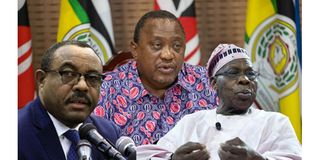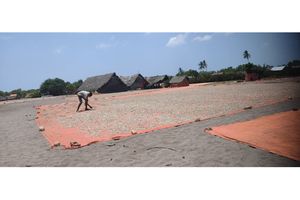Kenyatta, Obasanjo, and Desalegn tasked with reviving stalled DRC peace process

What you need to know:
The joint EAC-SADC summit has appointed former Kenyan President Uhuru Kenyatta, ex-Nigerian leader Olusegun Obasanjo, and former Ethiopian Prime Minister Hailemariam Desalegn as co-facilitators for the merged Luanda-Nairobi peace process in the DRC.
A joint summit of leaders of the East African Community (EAC) and the Southern African Development Community (SADC) has appointed two new facilitators for the peace bid for the Democratic Republic of Congo, formally merging two processes that have struggled to end hostilities.
The decision means that former President Uhuru Kenyatta of Kenya will stay on the mediation as a co-facilitator.
He will be joined by ex-Nigerian leader Olusegun Obasanjo and former Ethiopian Prime Minister Hailemariam Desalegn as co-facilitators of the merged Luanda-Nairobi process, a peace effort designed to persuade armed groups in eastern DRC to lay down their arms while also addressing tensions between Rwanda and DRC, which have accused each other of fomenting rebellions against their governments.
The decision was actually been made on February 8, when leaders of the EAC and SADC gathered in Tanzania’s commercial capital Dar es Salaam to discuss the ongoing violence in eastern DRC, where M23 rebel group has expanded territory in renewed violence.
A joint statement issued by Zimbabwean President Emmerson Mnangagwa, chair of SADC, and Kenya’s President William Ruto, chair of EAC, said warring sides in the Congo are now required to cease fire, and attend peace talks when called upon.
Already, Defence Chiefs from member states have been discussing how to help the DRC implement a ceasefire.
The military chiefs want an immediate ceasefire and unconditional cessation of hostilities, provision of humanitarian assistance, opening of main supply routes, “development of a securitisation plan for Goma and surrounding areas and immediate reopening of Goma Airport and advice on other facilitative interventions,” the joint statement indicated on Monday.
The decision on facilitators is both a compromise and meant to address the trust deficit that has existed in the last one year.
The Luanda Process, mediated by Angolan President Joao Lourenco was meant to address tensions between Rwanda and the DRC.
But of late, the ceasefire decisions have recently been violated and meetings skipped. A framework for monitoring violations was also never implemented, even though both countries had agreed to work on it.
The Nairobi Process under President Kenyatta was meant to bring armed groups to the table for dialogue with the government of DRC under President Felix Tshisekedi. But while Kinshasa was confident in Kenyatta’s mediation, it also refused meeting with M23, a group it accuses of being terrorist organisation. This departure was a bone of contention for Rwanda which has insisted on direct talks between Kinshasa and the M23.
In the meantime, the M23 have taken over Goma and Bukavu, two of the largest cities in eastern DRC. They then called for talks, vowing to heed the calls of regional leaders.
But President Tshisekedi said he won’t talk to them. Instead, he said he would rather talk with Rwanda, which he accuses of arming the M23.
Rwanda in turn accuses Kinshasa of shielding a rebel group known as the FDLR, remnants of those who carried out the 1994 genocide in Rwanda before fleeing to the DRC.
Kigali says the group still harbours ambitions to return to Kigali for power.
A joint meeting of EAC-SADC defence chiefs was due on Monday in Dar es Salaam to “work on the details of the ceasefire.”
“All actors are urged to observe the ceasefire announced by the ERAC-SADC Summit, and the M23 and all other actors are called upon to cease any further advancement in eastern DRC and to observe and abide by an immediate ceasefire,” the statement said.





